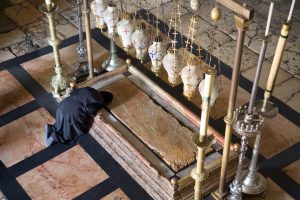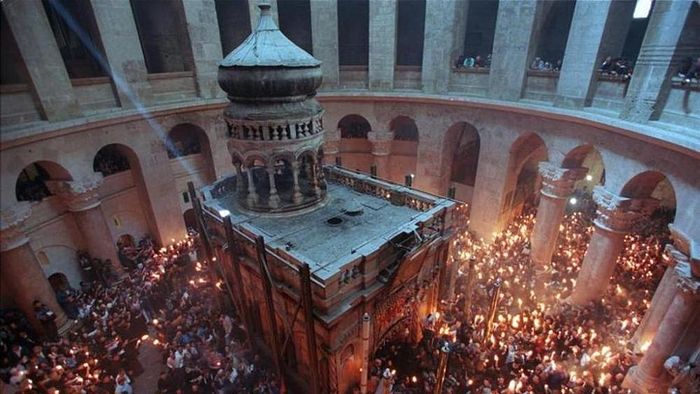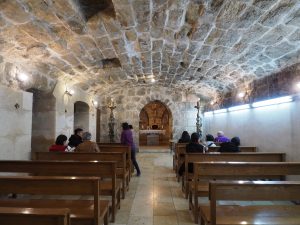42 When evening had come, and since it was the day of Preparation, that is, the day before the sabbath, 43 Joseph of Arimathea, a respected member of the council, who was also himself waiting expectantly for the kingdom of God, went boldly to Pilate and asked for the body of Jesus. 44 Then Pilate wondered if he were already dead; and summoning the centurion, he asked him whether he had been dead for some time. 45 When he learned from the centurion that he was dead, he granted the body to Joseph. 46 Then Joseph bought a linen cloth, and taking down the body; wrapped it in the linen cloth, and laid it in a tomb that had been hewn out of the rock. He then rolled a stone against the door of the tomb. 47 Mary Magdalene and Mary the mother of Jesus saw where the body was laid. [Mark 15:42-47, NRSV]
The Stone-of-Unction. The Aedicule The Crusaders’ Chapel (Photo credit: Dr. LL Chan)
The Church of the Holy Sepulchre is one of Jerusalem’s main landmarks and daily draws many pilgrims and visitors. It houses two holiest sites in Christianity: the sacred site where Jesus of Nazareth was crucified (Calvary or Golgotha) and Jesus’ empty tomb.
To this day, the Holy Sepulchre enjoys the spiritual focus of Christendom and ranks easily as its most important pilgrimage center. A sepulcher is defined as “a small room or monument, cut in rock or built of stone, in which a dead person is laid or buried”. The actual tomb is enclosed in the chapel called the Aedicule, located within a rotunda beneath the larger of the church’s two domes. The Aedicule has two rooms, the first holding the Angel’s Stone, which is believed to be a fragment of the large stone that sealed the tomb; the second is the tomb itself.
The burial of Jesus Christ forms part of the earliest gospel traditions. The earliest biblical reference is in Paul’s First Letter to the Corinthians soon after 50AD:
- 3 For I delivered to you as of first importance what I also received, that Christ died for our sins in accordance with the scriptures, 4 that he was buried, that he was raised on the third day in accordance with the scriptures… (1 Cor 15:3-4, RSV)
The extended narrative of Jesus’ passion, death and resurrection in all the four canonical Gospels, written between about 65 and 100 AD, include his burial. Some details may differ, but all four Gospels state that, on the evening of the Crucifixion, Joseph of Arimathea asked Pilate for the body and, after Pilate granted his request, he wrapped it in a linen cloth and laid it in a tomb.
Visitors know that when we say “the Church of the Holy Sepulchre”, we are referring to a complex of buildings. It is the site in the Old City of Jerusalem that is identified as the place both of the crucifixion and the tomb of Jesus of Nazareth. It is a major pilgrimage center for Christians all around the world, and the holiest of all Christian sites in the Holy Land. Human traffic is heavy at any time; if you have a good guide, as we did, he will try and slot you in at early morning when the place is less congested.
According to the New Testament, Jesus was crucified at Golgotha, “the place of the skull” (Matt. 27:33–37; Mark 15:22–26; Luke 23:33-34; John 19:17–18). This has been identified as an area of abandoned stone quarries just outside the city wall of the time. At the time, executions by crucifixion were carried out outside the city wall, but a decade or so later, a third wall was built that enclosed the area of the execution and burial within the city, and this accounts for the Holy Sepulchre’s location inside the Old City of Jerusalem today.
As with most popular Christian complexes in the Holy Land, and particularly so in regards to the Holy Sepulchre, we often read of a chequered history of construction, destruction, and rebuilding. In whatever era of the Holy Sepulchre’s state of building and rebuilding, pilgrims from all over the Christendom had been flocking to it, and they were treated well, even during the period when the city came under Muslim rulers. Things changed after the capture of the city by the Seljuk Turks in 1077 when rumors began to circulate that Christian pilgrims were being ill treated and denied access to the church. The First Crusade called by Pope Urban I between 1096 and 1099 had for its major aim the liberation of the holy places, the foremost of which was the Holy Sepulchre.
The Church of the Holy Sepulchre was reconsecrated on 15 July 1149, 50 years to the day after the capture of Jerusalem by the First Crusade. Even though work continued on the building for many years afterwards, the church of the crusaders is essentially the church that is to be seen today.
Reflection:
Of the many intense experiences shared among members of our group on their visit to the Holy Sepulchre complex, three stories are particularly striking.
1. “So blessed to be given so much time to pray at Jesus’ tomb”
Thanks to the foresight of Mr. Murad, we reached the Holy Sepulchre early and started to queue for our turn to enter the place that marked Jesus’ burial. In our previous visit, before we could even kneel down properly we were already chased off by the supervising Armenian priest, so that others could enter that extremely narrow space. This time round, everyone of the group was given ample time to kneel at the tomb and to say our prayers, making this a highlight of our pilgrimage and source of endless excited sharing afterwards.
2. “I just can’t tear myself away from the Stone of Anointing”
Right inside the entrance to the Holy Sepulchre complex is the Stone of Anointing, traditionally believed (since the crusader era) to be where Jesus’ body was prepared for burial by Joseph of Arimathea. Furthermore, the present stone was only put in place in the 1810 reconstruction. All this, nevertheless, does not dampen the spirit of popular religiosity amply reflected in women pouring out bagful of clothes, wiping them on the stone, and then bringing them home for blessing. This practice is much like pilgrims carting home holy water in big containers from church-approved holy sites around the world.
While some may be concerned that such religiosity may lead to unbridled piety and superstition, we also need to be aware that theologians who intellectually seek to fine-tune coherent truths and sound doctrines must also accommodate all the concrete reality of the human flesh – men and women in the streets and in our homes, and our restless hearts that forever yearn to rest in God.
In any case, this practice of popular religiosity was delightfully tempered by what we saw in two members from our group, both men who just wanted to remember and relate to Jesus’ suffering death. In one case, the man spread himself face down on the Stone, his whole torso practically on it, and there prayed and shed tears. When he did not obey an Armenian priest who asked him to give way to an Armenian bishop who wanted to touch and pray at the Stone, the bishop moved to another corner and parked himself there instead. In the second case, the man was so drawn to the Stone that he said he just kept coming back to it, walking round it. He cried so much, he said, that his eyes hurt.
3. Mass at the Crusaders’ Chapel
It was a wonderful experience to celebrate Mass at the Crusader’s Chapel, thanks to our guide’s able coordination to get the permission. As this chapel is located on an upper level, we were led through several rooms, staircases and corridors before we reached it. This added to our sense of the complexity of the structures associated with the Holy Sepulchre. Aesthetically beautiful, the chapel at once gave us an authentic 12th century feel about it.
Some pilgrims from America and some from the Philippines sought and obtained permission from Fr. Albert to join us at Mass. Just as they were exceedingly grateful to us for accommodating them, we in turn were delighted with their presence as they contributed to the heart-warming sense of the universality of the Body of Christ at the celebration of the Eucharist, the sacramental Body of Christ.
Copyright © Dr. Jeffrey & Angie Goh, May 2019. All rights reserved.
You are most welcome to respond to this post. Email your comments to jeffangiegoh@gmail.com. You can also be dialogue partners in this Ephphatha Coffee-Corner Ministry by sending us questions for discussion.



